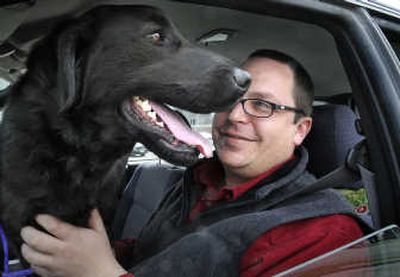Black dogs are least likely to be adopted

They can wag their tails, plead with chocolate eyes and show off sparkling personalities, but a dog with black fur is still the least likely to be adopted from an animal shelter.
“If we had a yellow Lab, a chocolate Lab and a black Lab side by side, the yellow one would be the first to go, then the chocolate,” said Patricia Simonet, animal behaviorist and program manager at Spokane County Animal Protection Services. “Even if the black Lab is the best behaved in the group, it is the last to go.”
Nobody tracks the problem nationally, and shelters often keep limited data on the sizes and breeds of the dogs that are adopted or euthanized, according to the Humane Society and the American Society for the Prevention of Cruelty to Animals.
But no one doubts that black dogs are at a disadvantage. Shelters in some communities call it “big black dog syndrome,” though many shelter officials say even small dogs are better off if their fur is any color but black.
The reasons aren’t entirely clear, though dog advocates say black dogs are difficult to photograph for online listings and are hard to spot against the shadows of their crates and cages. For that reason some of SCRAPS’ kennels are off-limits to black dogs that would melt into the background.
“We have to be careful to put them in the best-lit kennels,” Simonet said.
Kaci Winkler, volunteer coordinator at SpokAnimal CARE, said she thinks black dogs fall victim to superstition, like black cats.
Literature also works against them. The idea of a big, black dog unleashing destruction is a common theme in books, movies and folklore like “The Hound of the Baskervilles,” the “Harry Potter” series and “The Omen.” And Winston Churchill famously called his bouts of depression “the black dog.”
People are often wary of dark dogs because it’s difficult to read their expressions, said Paul Nicosi, the dog behavior specialist at Bide-A-Wee animal shelter in New York City. Without defined eyebrows, a playful grin might be construed as an angry grimace, he said.
But Simonet finds black dogs easy to read. When they’re nervous or upset, the whites of their eyes are quite visible, she noted.
Of course, when they’re snarling, their white teeth show up. Perhaps that’s why many “Beware of Dog” signs depict big, black dogs with teeth bared and gums dripping.
One Web site, blackpearldogs.com, is devoted to increasing public awareness of the problem and promises to make a difference “one black dog at a time.” It notes that fur color has no bearing on a dog’s temperament and even suggests – David Letterman style – the top 10 reasons for picking a black dog. Among them: The color doesn’t clash with furniture or clothing, it hides dirt well, and it’s easy to accessorize.
And who could resist the No. 1 Reason? “We need you.”